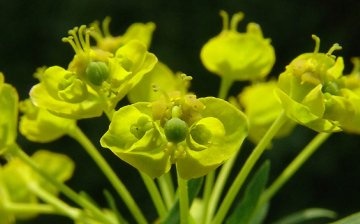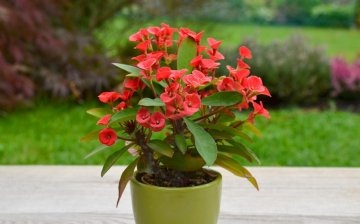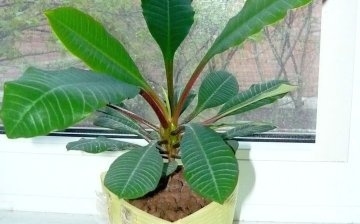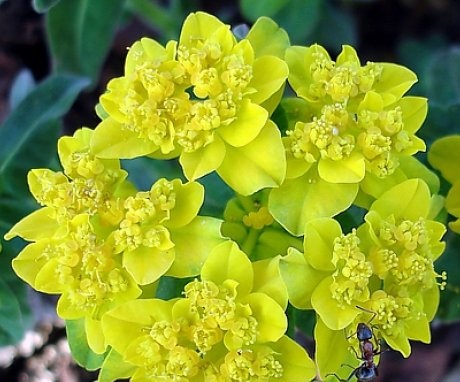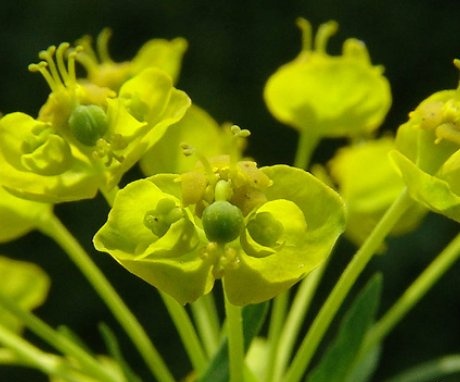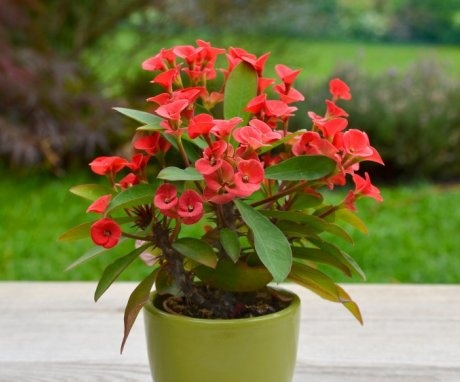Euphorbia: benefits, harms and contraindications
Spurge is a popular plant. It is unpretentious to care for and has many varieties. At first glance, the species of milkweed are so dissimilar in appearance that one cannot believe in their family ties. Each grower can choose the type of milkweed to his liking. A feature of this flower is poisonous sap, so you need to carefully choose a place for the plant and handle it carefully.
Content:
- Useful properties of milkweed
- Harm and contraindications
- Description of indoor flower, varieties of milkweed
- Tips for flower growers: how to grow euphorbia on a windowsill
Useful properties of milkweed
Euphorbia has long been known for its healing properties. It is not too safe to use it yourself at home, since milkweed juice becomes medicinal only after special treatment. The medicinal properties of milkweed were known even before our era. They were actively treated for various ailments, but only experienced healers knew the required concentration of the medicine. Even the poisonous qualities of milkweed have been used. So, in agriculture, the juice of this plant is used to combat bedbugs and caterpillars.
You can use all parts of the plant, it is only important to process them correctly.
Milkweed flowers are dried in the sun. The roots should be harvested in spring or fall when the flower has faded. The roots are washed and dried in the oven and then stored in a dry, dark place. The leaves can be dried on the windowsill. Milkweed juice can be collected as during the period flowering, and outside of it. The collected juice is brought to a boil in a water bath to thicken. After that, it can be stored in a cool place.
You can use euphorbia to treat the following ailments:
- With skin lesions. Infusion of milkweed can treat non-healing ulcers, warts, fungal infections. In no case should pure juice be applied to the skin, it leaves burns. For the treatment of skin diseases, milkweed leaves are brewed with boiling water and insisted for a while. Then I filter the infusion and make baths with it. In a diluted form, such an infusion is also effective.
- For the treatment of intestines and stomach. Euphorbia can have a laxative effect. For this, dried milkweed roots are used. They are boiled in water for no more than 10 minutes, then filtered and this broth is drunk in the morning on a tablespoon.
- For the treatment of the kidneys. Euphorbia is also known for its diuretic effect. You can drink the infusion or prepare an alcoholic tincture in the ratio of 1:30. This tincture is added drop by drop to water.
Harm and contraindications
Milkweed juice contains a substance called euphorin. It causes severe inflammation, irritation, burning sensation when it comes into contact with the skin and mucous membranes. There are known cases of coma after contact with a plant. Even as a folk remedy, using the juice of this plant can be dangerous. When pruning leaves and transplant it is imperative to wear gloves, then throw them away and wash your hands thoroughly with soap and water. Avoid splashing fresh juice on your skin. Do not use food utensils and kitchen knives when pruning and transplanting a plant.
When swallowed, milkweed juice causes stomach pain, nausea, and diarrhea.This plant is especially dangerous for young children, who can take a leaf in their mouth or touch the plant and then rub their eyes. Spurge should be placed as far away from the child as possible. Pets usually stay away from milkweed, as they smell poisonous plants. But some can still get poisoned, so it is not recommended to grow euphorbia on the windowsill if there are cats in the house.
If milkweed juice still gets on the skin or mucous membranes, you need to provide first aid:
- The affected skin area should be washed with soap and water and rinsed again with water. You cannot rinse your eyes with soap, but you can rinse them with water or saline.
- If you have a rash and signs of allergies, you need to take an age-appropriate antihistamine.
- If, after washing, a burn and a blister appear, it must be lubricated with Panthenol, Rescuer or other ointment for burns.
- The burn site must be protected from sunlight. If the condition worsens during the day, you should seek medical help.
- If a child swallows leaves, you need to call an ambulance before complications begin. The nursing staff will flush the baby's stomach. The condition of the child must be monitored.
Description of indoor flower, varieties of milkweed
Plant called Spurge belongs to the Euphorbia family. Under natural conditions, it grows in the countries of Africa, America, as well as on the island of Madagascar. Euphorbia loves warmth, moderate or low humidity, and a subtropical climate. The peculiarity of milkweed is its interesting appearance. Each variety of this plant is unique and differs significantly in its decorative characteristics.
Most often, spurge grows as a shrub or bonsai.
Euphorbia, the harm and benefits of which have long been known, should be placed on windows away from children and pets, since the juice of this plant is quite poisonous. It is believed that the Moorish healer Euphorb began to use the euphorbia, who was able to apply both useful and dangerous properties of this plant. The doctor used milkweed juice to heal the sick and poison those who were objectionable to the ruler.
This plant has over 2000 species. Each of them is unique in its own way. Some types of milkweed are so different that it is easy to mistake them for different plants:
- Poinsettia is one of the most beautiful types of milkweed. This flower is called the Star of Bethlehem. Red flowers appear just in time for Catholic Christmas. The leaves on the tops are also red, which looks very beautiful and unusual. However, this species of milkweed is quite finicky. He does not like bright sun, stuffiness and hot batteries.
- One of the most common types of milkweed is Euphorbia white-veined... It has a silvery trunk and can be up to 1.5 meters in height. The lower leaves on the trunk gradually fall off, and the plant takes the form of a palm tree.
- Euphorbia Mil has many thorns. It is a small shrub with bright red or pinkish small flowers. This plant is especially fond of light and needs good lighting. Euphorbia Milya must be pruned regularly, otherwise it begins to grow and branch very chaotically.
Tips for flower growers: how to grow euphorbia on a windowsill
Milkweed grow well and do not require complex care. They are able to accumulate water in the stem and fleshy leaves, so frequent watering is not required. Some types of milkweed are more capricious, but if the basic conditions of care are observed, problems with this plant will not arise.
Milkweed growing tips:
- Euphorbia tolerates high temperatures well, but it is advisable not to keep it at temperatures above 25 degrees. In winter, it is best to give the plant a dormant period and lower the temperature to 14 degrees.
- Some types of milkweed are more shade-loving than others, but everyone needs enough light. If there is enough light on the windowsill, then you need to accustom the flower gradually so that the sun's rays do not burn the leaves.With an excess of direct rays, the leaves begin to turn yellow and fall off. In winter, when there is little light, you need to take care of additional lighting.
- It is better to water the spurge less often than more often than the norm. From an excess of moisture, the roots rot, and the plant dies. Watering is necessary when the soil is already completely dry, but has not yet begun to crack from dryness. In winter, watering is as rare as possible.
- You need to feed the spurge with a special fertilizer for cacti. In summer, top dressing is carried out three times, in winter 1 time is enough. It is not recommended to feed with nitrogenous fertilizers, as the stems and leaves crack from them.
- Milkweed are used to dry climates, so there is no need to humidify the air and spray it. Regular watering is sufficient. Spraying may be needed if you decide to wash and wipe your flower.
- Euphorbia grows rapidly. A young plant is needed transplant annually, increasing the diameter of the pot, and the old euphorbia can be replanted every 3 years to renew the soil.
With improper care, the spurge can die or become deformed. Crooked stems are often formed when there is a lack of lighting and the absence of winter dormancy. The flower begins to reach for the light and bend.
More information about the beneficial properties of milkweed can be found in the video:





